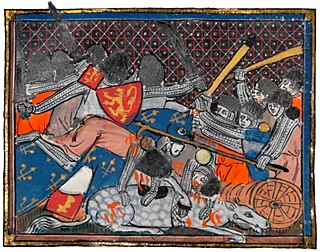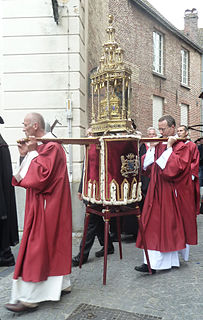Related Research Articles

The Battle of the Golden Spurs was a military confrontation between the royal army of France and rebellious forces of the County of Flanders on 11 July 1302 during the Franco-Flemish War (1297–1305). It took place near the town of Kortrijk (Courtrai) in modern-day Belgium and resulted in an unexpected victory for the Flemish. It is sometimes referred to as the Battle of Courtrai.

Jan Davidsz. de Heem or in-full Jan Davidszoon de Heem, also called Johannes de Heem or Johannes van Antwerpen or Jan Davidsz de Hem, was a still life painter who was active in Utrecht and Antwerp. He is a major representative of that genre in both Dutch and Flemish Baroque painting.

The Procession of the Holy Blood is a large religious Catholic procession, dating back to the Middle Ages, which takes place each Ascension Day in Bruges, Belgium. In 2009, it was included in the UNESCO Representative List of the Intangible Cultural Heritage of Humanity.

Paul de Vigne (1843–1901), Belgian sculptor, was born at Ghent. He created public monuments for display in Belgium and France.

Pieter de Coninck was a weaver from Bruges well known for his role in the events surrounding the Battle of the Golden Spurs. He was not the head of the weavers' guild as is popularly believed. Together with Jan Breydel, a butcher, he was in the forefront of the popular uprising that led to the Battle of the Golden Spurs. Right before that battle he was knighted together with two of his sons.

Jan Breydel is credited with leading the Bruges Matins, a violent uprising against Philip the Fair. He is said to have played a major role in the Franco-Flemish War, even though his authenticity has since been questioned.

Pieter Jansz. Pourbus was a Flemish Renaissance painter, draftsman, engineer and cartographer who was active in Bruges during the 16th century. He is known primarily for his religious and portrait paintings.

The Matins of Bruges was the nocturnal massacre of the French garrison in Bruges and their Leliaert supporters on 18 May 1302 by the members of the local Flemish militia. It has been named "Matins" in analogy to the Sicilian Vespers of 1282. The revolt led to the Battle of the Golden Spurs, which saw the Flemish militia defeat French troops on 11 July 1302.

Julius Ludovicus Maria Sabbe was a Flemish publisher and an active member of the Flemish movement. From 24 September 1869 on, he taught Dutch at the Koninklijk Atheneum of Bruges.

The Museum of Fine Arts in Ghent, Belgium, is situated at the East side of the Citadelpark.

The Markt of Bruges is located in the heart of the city and covers an area of about 1 hectare. Some historical highlights around the square include the 12th-century belfry and the West Flanders Provincial Court (originally the Waterhall, which in 1787 was demolished and replaced by a classicist building that from 1850 served as provincial court and after a fire in 1878 was rebuilt in a neo-Gothic style in 1887. In the center of the market stands the statue of Jan Breydel and Pieter de Coninck.

David de Coninck or David de Koninck, also known as Rammelaer was a Flemish painter who specialised in still lifes and landscapes with animals and hunting scenes. Recognised as a leading animal painter, de Coninck was able to develop an international career which caused him to work for extended periods in Paris, Rome and Vienna.

Andries Benedetti was a Flemish still life painter mainly active in Antwerp who is known for his fruit still lifes and pronkstillevens.

Bruges is the capital and largest city of the province of West Flanders in the Flemish Region of Belgium, in the northwest of the country, and the seventh-largest city of the country by population.

Ter Doest Abbey was a Cistercian abbey in Belgium, in the present Lissewege, a district of Bruges, West Flanders.

Willem van Saeftinghe was a lay brother in the Cistercian abbey of Ter Doest in Lissewege, West Flanders, Belgium. He fought at the Battle of the Golden Spurs, and became a Flemish folk hero.

Ten Duinen Abbey or the Abbey of the Dunes was a Cistercian monastery at Koksijde in what is now Belgium. It was one of the richest and most influential religious institutions in the medieval County of Flanders. It later relocated to the city of Bruges.

Andries de Coninck or Andries de Koninck was a Flemish art dealer and still life painter active in Antwerp. He is known for his pronkstillevens, the still lifes that were popular in Flanders and the Dutch Republic from the 1640s.
References
- ↑ Verbruggen, J, & Falter, R. (2002) 1302: Opstand in Vlaanderen. ISBN 9020944126.